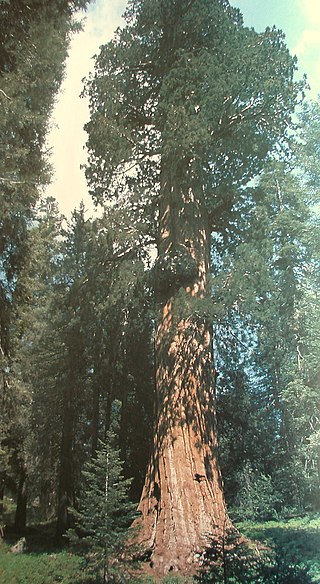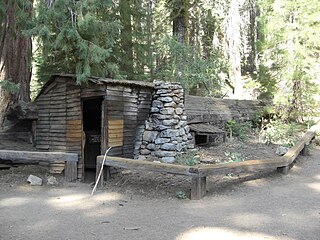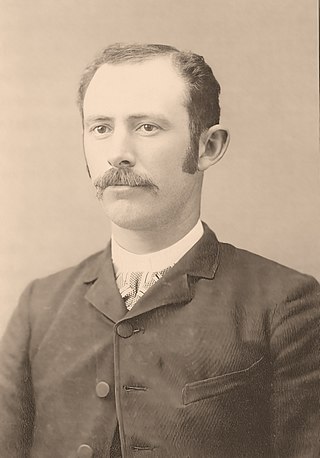
Three Rivers is an unincorporated community in Tulare County, California, United States. Located in the foothills of the Sierra Nevada at the edge of the San Joaquin Valley, the town is near the entrance to the national parks of Sequoia and Kings Canyon. The town's name comes from its location near the junction of the North, Middle, and South Forks of the Kaweah River.

General Sherman is a giant sequoia tree located at an elevation of 2,109 m (6,919 ft) above sea level in the Giant Forest of Sequoia National Park in Tulare County, in the U.S. state of California. By volume, it is the largest known living single-stem tree on Earth.

Sequoia National Park is an American national park in the southern Sierra Nevada east of Visalia, California. The park was established on September 25, 1890, and today protects 404,064 acres of forested mountainous terrain. Encompassing a vertical relief of nearly 13,000 feet (4,000 m), the park contains the highest point in the contiguous United States, Mount Whitney, at 14,505 feet (4,421 m) above sea level. The park is south of, and contiguous with, Kings Canyon National Park; both parks are administered by the National Park Service together as the Sequoia and Kings Canyon National Parks. UNESCO designated the areas as Sequoia-Kings Canyon Biosphere Reserve in 1976.

General Grant Grove, a section of the greater Kings Canyon National Park, was established by the U.S. Congress in 1890 and is located in Fresno County, California. The primary attraction of General Grant Grove is the giant sequoia trees that populate the grove. General Grant Grove's most well-known tree is called General Grant, which is 267 ft (81 m) tall and the third-largest known tree in the world. The General Grant tree is over 1,500 years old and is known as the United States' national Christmas tree. General Grant Grove consists of 154 acres (0.62 km2) and is geographically isolated from the rest of Kings Canyon National Park.

Sequoia National Forest is located in the southern Sierra Nevada mountains of California. The U.S. National Forest is named for the majestic Giant Sequoia trees which populate 38 distinct groves within the boundaries of the forest.

The Ruskin Colony was a utopian socialist colony in the southern US at the end of the 19th century.

Mineral King is a subalpine glacial valley located in the southern part of Sequoia National Park, in the U.S. state of California. The valley lies at the headwaters of the East Fork of the Kaweah River, which rises at the eastern part of the valley and flows northwest. Accessed by a long and narrow winding road, the valley is mostly popular with backpackers and hikers.

The Kaweah River is a river draining the southern Sierra Nevada in Tulare County, California in the United States. Fed primarily by high elevation snowmelt along the Great Western Divide, the Kaweah begins as four forks in Sequoia National Park, where the watershed is noted for its alpine scenery and its dense concentrations of giant sequoias, the largest trees on Earth. It then flows in a southwest direction to Lake Kaweah – the only major reservoir on the river – and into the San Joaquin Valley, where it diverges into multiple channels across an alluvial plain around Visalia. With its Middle Fork headwaters starting at almost 13,000 feet (4,000 m) above sea level, the river has a vertical drop of nearly two and a half miles (4.0 km) on its short run to the San Joaquin Valley, making it one of the steepest river drainages in the United States. Although the main stem of the Kaweah is only 33.6 miles (54.1 km) long, its total length including headwaters and lower branches is nearly 100 miles (160 km).

The Giant Forest, famed for its giant sequoia trees, is within the United States' Sequoia National Park. This montane forest, situated at over 6,000 ft (1,800 m) above mean sea level in the western Sierra Nevada of California, covers an area of 1,880 acres (7.6 km2). The Giant Forest is the most accessible of all giant sequoia groves, as it has over 40 mi (64 km) of hiking trails.

Llano del Rio was a commune located in what is now Llano, California, east of Palmdale in the Antelope Valley, Los Angeles County. The colony was devised by lawyer and socialist politician Job Harriman after he had failed his bid to become the mayor of Los Angeles in 1911. The colony's land was acquired in 1913 and it was formally launched on May 1, 1914.

The Kaweah Gap is the lowest east–west pass through the Great Western Divide, in Sequoia National Park, California, United States. The High Sierra Trail is routed through this pass.

Atwell Mill Grove is a giant sequoia grove in the east fork of the Kaweah watershed area in California. Can be accessed via the Mineral King Road which branches off California State Route 198 below the south entrance to Sequoia National Park.

Tharp's Log is a hollowed giant sequoia log at Log Meadow in the Giant Forest grove of Sequoia National Park that was used as a shelter by early pioneers. The log is named after Hale D. Tharp, who was described as the first Non-Native American to enter the Giant Forest.

The Squatter's Cabin is the only remnant of the Kaweah Colony, a socialist utopian group established in the Sierra Nevada in the 1880s. Now located in Sequoia National Park, the one-room log structure is located at Huckleberry Meadow near the Giant Forest.
Kaweah is a word in the ancient Yokuts language that means "crow" or "raven cry".

Hale Dixon Tharp was a miner during the California Gold Rush, and the first non-Native American settler to enter Giant Forest, in what is now Sequoia National Park.

Utopian socialism is the term often used to describe the first current of modern socialism and socialist thought as exemplified by the work of Henri de Saint-Simon, Charles Fourier, Étienne Cabet, and Robert Owen. Utopian socialism is often described as the presentation of visions and outlines for imaginary or futuristic ideal societies, with positive ideals being the main reason for moving society in such a direction. Later socialists and critics of utopian socialism viewed utopian socialism as not being grounded in actual material conditions of existing society. These visions of ideal societies competed with revolutionary and social democratic movements.

The Pioneer Cabin Tree, also known as The Tunnel Tree, was a giant sequoia in Calaveras Big Trees State Park, California. It was considered one of the U.S.'s most famous trees, and drew thousands of visitors annually. It was estimated to have been more than 1,000 years old, and measured 33 feet (10 m) in diameter; its exact age and height were not known. The tree was topped before 1859. It fell and shattered during a storm on January 8, 2017.
Burnette Haskell was an American radical best known for co-founding the Kaweah Co-operative Commonwealth. He was also involved in anarchist and labor causes.

Charles Clifford Curtis (1862-1956) was a pioneering American photographer who is best remembered for his documentary photography of the logging industry in the Sierra Nevada mountains in the late 19th century. His photographs, which captured the felling of the famous Mark Twain Tree and the General Noble tree, helped to convince the public that these giant sequoias were not a hoax. Curtis was well known for his use of large plate photography, which allowed him to capture portraits of people and gatherings that were dwarfed by the scale of the giant trees. His images of logging crews working in the rugged terrain of Converse Basin are considered some of the most iconic and enduring images of the era.

















